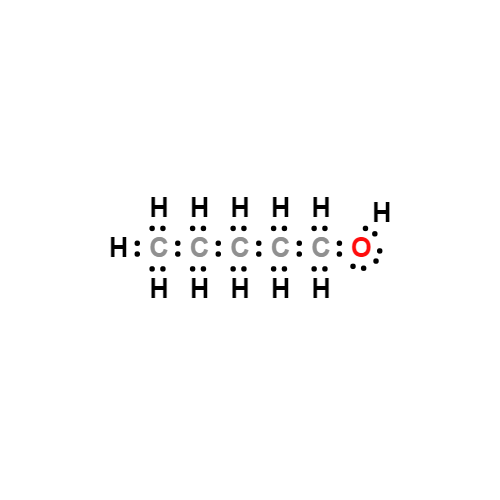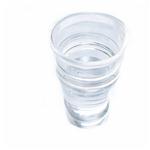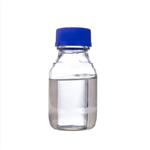Description
1-Pentanol is a monohydroxy alcohol. It is a colorless liquid with a characteristic odor. Its combustion properties have been studied as it shows promising features to be an alternative to gasoline and diesel fuels. The conversion of 1-pentanol to di-n-pentyl ether (DNPE) in liquid phase at 423K in a batch reactor using ion exchange resins as catalysts.
Chemical Properties
1-Pentanol is a clear, colorless liquid at ambient temperatures, it has a characteristic fusel-like sweet and pleasant odor and burning taste. The air odor detection level (lowest perceptible level) was
reported as 10 ppm for 1-pentanol.
Occurrence
Reported found in banana, sweet cherry, cranberry, bourbon, vanilla, rice bran and Brazil nut.
Uses
Raw material for pharmaceutical preparations;organic synthesis solvent.
1-Pentanol is used as a key starting material in the production of dichloro-acetic acid pentyl ester, 2-methyltetrahydrofuran, di-n-penyl ether (DNPE), pentyl butyrate and amyl acetate. As a solvent, it is used for coating CDs and DVDs. It has been considered to be a replacement for gasoline and diesel fuels due to its combustion properties. Further, it is used as a reagent to prepare derivatives of ferulic acid and caffeic acid, which shows anticancer properties.
Uses
1-Pentanol may be used as a cosurfactant in the water-in-oil mixed surfactant microemulsions.
Production Methods
1-Pentanol is made primarily by the oxo process, which
involves the reaction of butenes with carbon monoxide and hydrogen in the presence of a catalyst, followed by
hydrogenation. 1-Pentanol is used as a solvent,
as a chemical intermediate for esters, and as a food additive
and flavoring substance. The primary routes
of industrial exposure are by dermal contact and inhalation.
Definition
ChEBI: An alkyl alcohol that is pentane in which a hydrogen of one of the methyl groups is substituted by a hydroxy group. It has been isolated from Melicope ptelefolia.
Aroma threshold values
Detection at 1.6 to 70 ppm
Taste threshold values
Taste characteristics at 50 ppm: intense fusel, fermented, bready and cereal with a fruity undertone
Air & Water Reactions
1-Pentanol is highly flammable. Soluble in water.
Reactivity Profile
Moderately toxic, flammable if exposed to powerful oxidizers. Incompatible with oxidizing materials, hydrogen trisulfide [Sax, 9th ed., 1996, p. 224].
Hazard
Lower explosive level in air 1.2% by volume. Moderate fire risk.
Health Hazard
Irritation of skin, eyes, and respiratory tract; headache and vertigo; dyspnea and cough; nausea, vomiting, and diarrhea. Double vision, deafness, delirium, and occasionally fatal poisoning, preceded by severe nervous symptoms, have been reported. Coma, glycosuria, and methemoglobinemia can occur.
Fire Hazard
HIGHLY FLAMMABLE: Will be easily ignited by heat, sparks or flames. Vapors may form explosive mixtures with air. Vapors may travel to source of ignition and flash back. Most vapors are heavier than air. They will spread along ground and collect in low or confined areas (sewers, basements, tanks). Vapor explosion hazard indoors, outdoors or in sewers. Runoff to sewer may create fire or explosion hazard. Containers may explode when heated. Many liquids are lighter than water.
Safety Profile
1-Pentanol is moderately toxic by ingestion and skin contact. An eye and upper respiratory irritant by inhalation. A severe skin and eye irritant. Ingestion can cause headache, nausea, vomiting, delirium, and methemoglobin formation. Mutation data reported. Extremely flammable if exposed to heat, flame, or powerful oxiduers. Moderately explosive when exposed to flame. Incompatible with oxidzing materials, hydrogen trisulfide. To fight fire, use alcohol foam, dry chemical.
Potential Exposure
(n-isomer); Suspected reprotoxic hazard,
Primary irritant (w/o allergic reaction), (iso-, primary):
Possible risk of forming tumors, Primary irritant (w/o allergic
reaction), (sec-, active primary-, and other isomers)
Primary irritant (w/o allergic reaction). Used as a solvent in
organic synthesis and synthetic flavoring, pharmaceuticals,
corrosion inhibitors; making plastics and other chemicals;
as a flotation agent. The (n-isomer) is used in preparation
of oil additives, plasticizers, synthetic lubricants, and as a
solvent.
First aid
Skin contact contributes significantly to overallexposure. If this chemical gets into the eyes, remove anycontact lenses at once and irrigate immediately for at least15 min, occasionally lifting upper and lower lids. Seek medical attention immediately. If this chemical contacts theskin, remove contaminated clothing and wash immediatelywith soap and water. Seek medical attention immediately. Ifthis chemical has been inhaled, remove from exposure,begin rescue breathing (using universal precautions, including resuscitation mask) if breathing has stopped and CPR ifheart action has stopped. Transfer promptly to a medicalfacility. When this chemical has been swallowed, get medical attention. Give large quantities of water and inducevomiting. Do not make an unconscious person vomit.
storage
Color Code—Red: Flammability Hazard: Store ina flammable liquid storage area or approved cabinet awayfrom ignition sources and corrosive and reactive materials.Prior to working with this chemical you should be trained onits proper handling and storage. Before entering confinedspace where amyl alcohols may be present, check to makesure that an explosive concentration does not exist. Store intightly closed containers in a cool, well-ventilated area awayfrom strong oxidizers; strong acids and hydrogen trifluoride;since violent reactions occur. Metal containers involving thetransfer of this chemical should be grounded and bonded.Where possible, automatically pump liquid from drums orother storage containers to process containers. Drums mustbe equipped with self-closing valves, pressure vacuumbungs; and flame arresters. Use only nonsparking tools andequipment, especially when opening and closing containersof this chemical. Sources of ignition, such as smoking andopen flames, are prohibited where this chemical is used,handled, or stored in a manner that could create a potentialfire or explosion hazard.
Shipping
UN2811 Pentanols, Hazard Class: 3; Labels: 3-
Flammable liquid. UN1987 Alcohols, n.o.s., Hazard Class:
3; Labels: 3-Flammable liquid.
Purification Methods
Dry 1-pentanol with anhydrous K2CO3 or CaSO4, filter and fractionally distil it. It has also been treated with 1-2% of sodium and heated at reflux for 15hours to remove water and chlorides. Traces of water can be removed from the near-dry alcohol by refluxing it with a small amount of sodium in the presence of 2-3% n-amyl phthalate or succinate followed by distillation (see ethanol). Small amounts of amyl alcohol have been purified by esterifying with p-hydroxybenzoic acid, recrystallising the ester from CS2, saponifying with ethanolic-KOH, drying with CaSO4 and fractionally distilling [Olivier Recl Trav Chim Pays-Bas 55 1027 1936]. [Beilstein 1 IV 1640.]
Toxicity evaluation
Moderately toxic by ingestion. Vapors may irritate skin and eyes.
Incompatibilities
Forms an explosive mixture with air.
Contact with strong oxidizers and hydrogen trisulfide may
cause fire and explosions. Incompatible with strong acids.
Violent reaction with alkaline earth metals forming hydrogen,
a flammable gas.
Toxics Screening Level
The ITSL for amyl alcohol is 120 μg/m3 based on an annual averaging time.
Waste Disposal
Dissolve or mix the material
with a combustible solvent and burn in a chemical incinerator
equipped with an afterburner and scrubber. All federal,
state, and local environmental regulations must be
observed.







